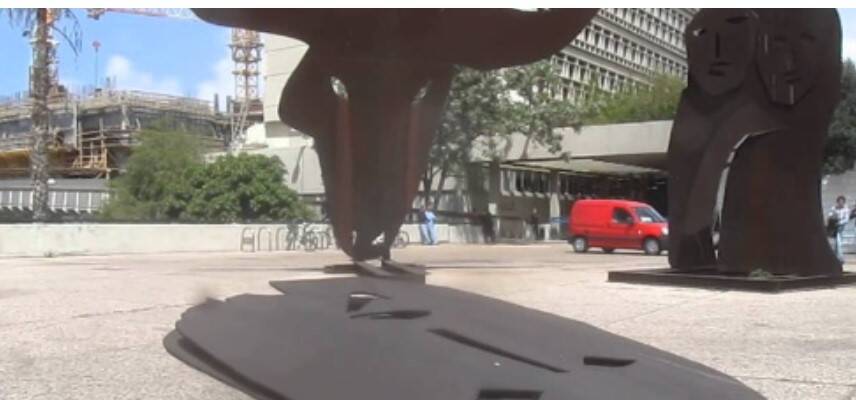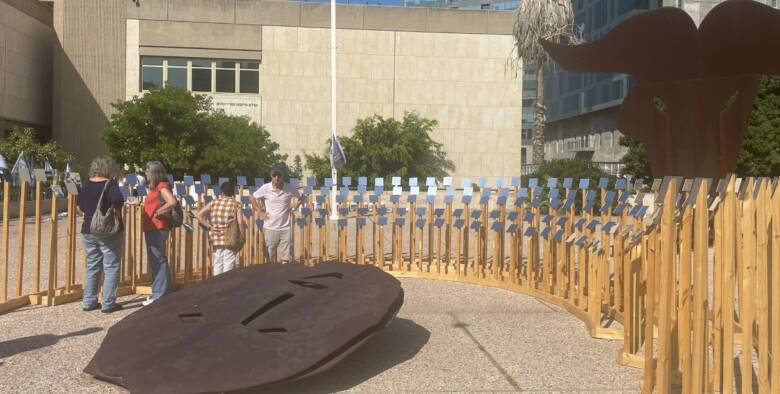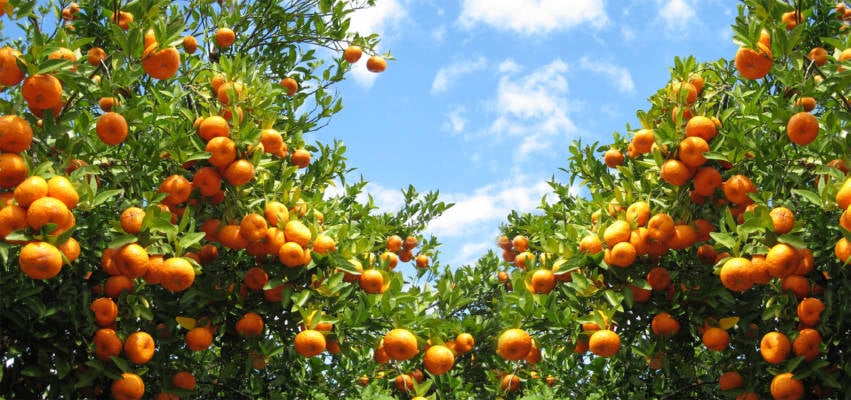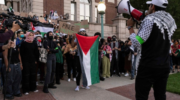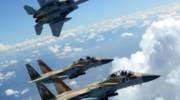The alteration of ‘Sacrifice of Isaac’ and its crucial location in Hostages Square has intensified the sculpture’s meaning amid the current conflict.
By Samantha Baskind, JNS
A Shabbat table installed in Tel Aviv with some 200 empty chairs for the Israeli hostages Hamas kidnapped and dragged back into the Gaza Strip—and copycats worldwide, including near the U.S. Capitol in Washington—have garnered international press coverage.
Much less discussed are the other artworks installed in what has been dubbed Hostages Square, outside the Tel Aviv Museum of Art. Upon visiting the site, it was quickly clear on a Jewish studies scholars’ solidarity mission to Israel this month that the overshadowed works have also been enlisted in the fight for the Israeli hostages and that some of these works carry much broader symbolism than the table.
Art transformed
The painter and sculptor Menashe Kadishman (1932-2015) was one of the icons of Israeli art. Much of his work drew on ovine imagery, including displaying live sheep painted blue at the Venice Biennale in 1978. The Guardian, a London-based news outlet, recorded in his obituary that he brought “a shepherd’s eye for nature” to his work.
One of Kadishman’s best-known and most poignant installations is “Shalekhet” (“Fallen Leaves”) at the Jewish Museum Berlin, which describes the work as “more than 10,000 faces with open mouths, cut from heavy round iron plates” covering the floor of the museum’s ground floor “void.”
Beside the Tel Aviv Museum of Art, Kadishman’s 1985 cor-ten (weathered) steel sculpture “Sacrifice of Isaac” rises imposingly. The artist repeatedly, even obsessively, returned for decades to the biblical story of the binding of Isaac, and by some counts, the 1995 Israel Prize winner represented sheep thousands of times in his drawings, paintings, and sculptures. The Tel Aviv sculpture, versions of which can be found in other museum collections, represents Isaac’s story in a semi-abstract fashion.
A flattened silhouette of a ram’s head—perhaps a cousin of the Chicago Bulls logo—stands upright, beside an abstracted form, with two mourning women’s faces, while a third face (Isaac) lies nearby on the ground.
Instead of the conventional Genesis account of Abraham and his unthinkable dilemma in response to the Divine command to slaughter his son, which typically portrays Isaac as an innocent victim, Kadishman’s sculpture casts Isaac and the ram in silent conflict. The artist has boldly eliminated the story’s three main active characters—Abraham, God, and the intervening angel—instead placing the ram, the replacement sacrifice, at center stage.
New meaning
Since Oct. 7, when Hamas terrorists invaded the Gaza border and attacked Jewish communities in southern Israel, Kadishman’s sculpture has been thrown into dialogue not only with the symbolic Shabbat table but also with another new installation called “Pieces of Light.”
Sponsored by the Hostages and Missing Families Forum, “Pieces of Light” was the first new work made for the square after the terror attack on that Black Shabbat and Simchat Torah holiday; it is installed within Kadishman’s sculpture.
The new work is tied to millennia of Jewish history, as well as that of the modern-day State of Israel. The forum contacted artist Keren Zach just two weeks after Oct. 7 and asked her—within 24 hours—to create an installation for the plaza.
“They wanted to quickly make noise about the missing,” Zach told JNS. “From the shock and agony, we created ‘Pieces of Light.”
Zach created the work with Tom Love, her co-owner of Love design studio, and designer Elad Kalai. The trio quickly decided that reflections would best convey the message it sought, so it secured a donation of 200 small mirrors from a local factory. The next day, Zach, and her employees and friends, built the installation—a semicircle of mirrors on wooden posts, like a choir, surrounding Kadishman’s Isaac—in five hours.
“The devotion was shared by everyone,” Zach told JNS. “We are united under this pain, and it felt right. It still does.”
The mirrors simultaneously reflect the viewer’s face––anyone could be a hostage––and the sunlight, giving hope to a beleaguered nation. A statement near the installation declares it a reminder that “some of our missing loved ones are still here and can be saved”; that “this could have easily been us instead of them”; that “hope, like light, will never stop to shine”; and that “we are all beings of light.”
At first, “Pieces of Light” was erected a few feet from Kadishman’s sculpture, but just as construction was complete, a police officer notified the group that it was too close to the entrance of a bomb shelter and had to be moved.
“After checking where our art would be best placed, suddenly the combination with Kadishman’s statue felt fitting and accurate,” Zach said.
Isaac mourns the hostages
In biblical and rabbinic tradition, the biblical matriarch Rachel, who was buried en route to Bethlehem, often cries and implores God to protect her children: the Jewish people. In Hostages Square, the sculpture of her father-in-law Isaac now takes on an active role in engaging with Israeli hostages.
By encircling Kadishman’s Isaac figure, “Pieces of Light” brings that future biblical patriarch to the fore, replacing the ram.
Inadvertently, fencing the museum erected to protect other parts of Kadishman’s sculpture has fully isolated Isaac from the ram and grieving women. Like the hostages, he is as alone as ever.
Kadishman began to concentrate on the oft-told Genesis story in 1982, spurred by Israel’s first war in Lebanon. The artist, whose son was drafted into the Israeli army, saw Isaac’s predicament in contemporary terms—endemic to an Israeli society always on the precipice of war.
“My father was in the Haganah, and I was in the army, too; I was Isaac, and he was Abraham,” Kadishman said in a 2012 interview. “Now I am Abraham, and my son is Isaac.”
The alteration of his “Sacrifice of Isaac” and its crucial location in Hostages Square has intensified the sculpture’s meaning amid the current conflict.
“I thought that every boy who died in the war was the figure of the ever-sacrificed son, who didn’t have a ram as a substitute,” Kadishman said in the interview.
But now, with Isaac surrounded and isolated by “Pieces of Light” in Hostages Square, he no longer represents only Israeli boys who are soldiers.
Kadishman’s work can still be understood as a reminder of the cost of war—any war—and the solemn responsibility of leaders, who have the power to commit young men and women to conflict.
In conjunction with “Pieces of Light,” it may offer hope to the families of the hostages who commissioned the newer piece. Many hope it will also speak to leaders who make the decisions that will bring the hostages home.
MAKE THE LAND OF ISRAEL EVEN MORE BEAUTIFUL!
PLANT YOUR VERY OWN FRUIT TREES IN ISRAEL!
Farmers near the Gaza border lost family, friends and workers. Spring is here, and they desperately need help to replant the farms. Join us in blessing the People and Land of Israel.
“I will ordain My blessing for you…” (Leviticus 25:4)
